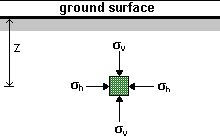 Total stress
increases with depth and with unit weight: Vertical total stress at depth z,
Total stress
increases with depth and with unit weight: Vertical total stress at depth z,- sv = g.z
Total stress |
Top |
 The total vertical stress
acting at a point below the ground surface is due to the weight of everythinglying
above: soil, water, and surface loading. Total stresses are calculated
from the unit weight
of the soil.
The total vertical stress
acting at a point below the ground surface is due to the weight of everythinglying
above: soil, water, and surface loading. Total stresses are calculated
from the unit weight
of the soil.
Unit weight ranges are:
| dry soil | gd | 14 - 20 kN/m³ | (average 17kN/m³) |
| saturated soil | gg | 18 - 23 kN/m³ | (average 20kN/m³) |
| water | gw | 9.81 kN/m³ | (» 10 kN/m³) |
See Description and classification
Any change in vertical total stress (sv) may also result in a change in the horizontal total stress (sh) at the same point. The relationships between vertical and horizontal stress are complex.
Total stress in homogeneous soil |
total stress |
 Total stress
increases with depth and with unit weight: Vertical total stress at depth z,
Total stress
increases with depth and with unit weight: Vertical total stress at depth z,
Total stress below a river or lake |
total stress |
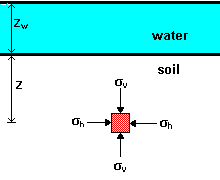 The
total stress is the sum of the weight of the soil up to the surface and
the weight of water above this: Vertical total stress at depth z,
The
total stress is the sum of the weight of the soil up to the surface and
the weight of water above this: Vertical total stress at depth z,
Total stress in unsaturated soil |
total stress |
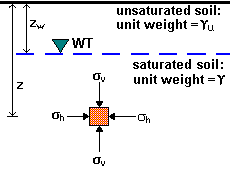 Just above
the water table the soil will remain saturated due to capillarity, but
at some distance above the water table the soil will become unsaturated,
with a consequent reduction in unit weight (unsaturated unit weight = gu)
Just above
the water table the soil will remain saturated due to capillarity, but
at some distance above the water table the soil will become unsaturated,
with a consequent reduction in unit weight (unsaturated unit weight = gu)
sv = gw . zw + gg(z - zw)
The height above the water table up to which the soil will remain
saturated depends on the grain size.
See Negative pore pressure (suction).
Total stress with a surface surcharge load |
total stress |
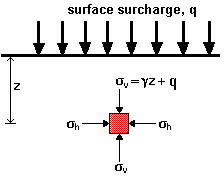 The addition of a surface surcharge
load will increase the total stresses below it. If the surcharge loading is
extensively wide, the increase in vertical total stress below it may be considered
constant with depth and equal to the magnitude of the surcharge.
The addition of a surface surcharge
load will increase the total stresses below it. If the surcharge loading is
extensively wide, the increase in vertical total stress below it may be considered
constant with depth and equal to the magnitude of the surcharge.
Pore pressure |
Top |
Groundwater and hydrostatic pressure |
Pore pressure |
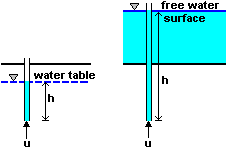 Under hydrostatic
conditions (no water flow) the pore pressure at a given point is given by
the hydrostatic pressure:
Under hydrostatic
conditions (no water flow) the pore pressure at a given point is given by
the hydrostatic pressure:
Water table, phreatic surface |
Pore pressure |
 The natural static
level of water in the ground is called the water table or the phreatic
surface (or sometimes the groundwater level). Under conditions of
no seepage flow, the water table will be horizontal, as in the surface of a
lake. The magnitude of the pore pressure at the water table is zero. Below the
water table, pore pressures are positive.
The natural static
level of water in the ground is called the water table or the phreatic
surface (or sometimes the groundwater level). Under conditions of
no seepage flow, the water table will be horizontal, as in the surface of a
lake. The magnitude of the pore pressure at the water table is zero. Below the
water table, pore pressures are positive.
Negative pore pressure (suction) |
Pore pressure |
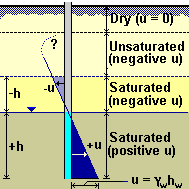 Below the water table,
pore pressures are positive. In dry soil, the pore pressure is zero.
Above the water table, when the soil is saturated, pore pressure will be negative.
Below the water table,
pore pressures are positive. In dry soil, the pore pressure is zero.
Above the water table, when the soil is saturated, pore pressure will be negative.
The height above the water table to which the soil is saturated is called
the capillary rise, and this depends on the grain size and type (and
thus the size of pores):
· in coarse soils capillary rise is very small
· in silts it may be up to 2m
· in clays it can be over 20m
Pore water and pore air pressure |
Pore pressure |
 Between the ground
surface and the top of the saturated zone, the soil will often be partially
saturated, i.e. the pores contain a mixture of water and air. The pore pressure
in a partially saturated soil consists of two components:
Between the ground
surface and the top of the saturated zone, the soil will often be partially
saturated, i.e. the pores contain a mixture of water and air. The pore pressure
in a partially saturated soil consists of two components:
Pore pressure in steady state seepage conditions |
Pore pressure |
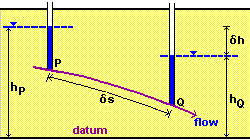 In conditions of
seepage in the ground there is a change in pore pressure. Consider seepage occurring
between two points P and Q.
In conditions of
seepage in the ground there is a change in pore pressure. Consider seepage occurring
between two points P and Q.
The hydralic gradient, i, between two points is the head drop per
unit length between these points. It can be thougth of as the "potential"
driving the water flow.
| Hydralic gradient P-Q, | i = - | dh ds |
= | du ds |
. | 1 gw |
| Thus | du = i . gw . ds | |||||
But in steady-state seepage, i = constant
Therefore the change in pore pressure due to seepage alone, dus
= i . gw . s
For seepage flow vertically downward, i is negative
For seepage flow vertically upward, i is positive.
Effective stress |
Top |
In fact, it is the combined effect of total stress and pore pressure that controls soil behaviour such as shear strength, compression and distortion. The difference between the total stress and the pore pressure is called the effective stress:
effective stress = total stress - pore pressureor s´ = s - u
Note that the prime (dash mark ´ ) indicates effective stress.
Terzaghi's principle and equation |
Effective stress |
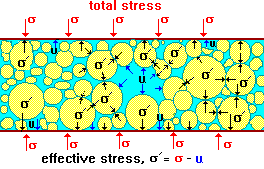 Karl Terzaghi was
born in Vienna and subsequently became a professor of soil mechanics in the
USA. He was the first person to propose the relationship for effective stress
(in 1936):
Karl Terzaghi was
born in Vienna and subsequently became a professor of soil mechanics in the
USA. He was the first person to propose the relationship for effective stress
(in 1936):
All measurable effects of a change of stress, such as compression, distortion and a change of shearing resistance are due exclusively to changes in effective stress. The effective stress s´ is related to total stress and pore pressure by s´ = s - u.
The adjective 'effective' is particularly apt, because it is effective
stress that is effective in causing important changes: changes in strength,
changes in volume, changes in shape. It does not represent the exact contact
stress between particles but the distribution of load carried by the soil
over the area considered.
Mohr circles for total and effective stress |
Effective stress |

Mohr circles can be drawn for both total and effective stress. The points
E and T represent the total and effective stresses on the same plane. The
two circles are displaced along the normal stress axis by the amount of pore
pressure (sn = sn'
+ u), and their diameters are the same. The total and effective shear
stresses are equal (t´ = t).
The importance of effective stress |
Effective stress |
Changes in water level below ground (water table changes) result in changes in effective stresses below the water table. Changes in water level above ground (e.g. in lakes, rivers, etc.) do not cause changes in effective stresses in the ground below.
Changes in effective stress |
Effective stress |
If both total stress and pore pressure change by the same amount, the effective
stress remains constant. A change in effective stress will cause: a change
in strength and a change in volume.
Changes in strength |
Changes in effective stress |
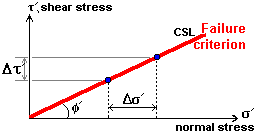 The critical
shear strength of soil is proportional to the effective normal stress; thus,
a change in effective stress brings about a change in strength.
The critical
shear strength of soil is proportional to the effective normal stress; thus,
a change in effective stress brings about a change in strength.
Therefore, if the pore pressure in a soil slope increases, effective stresses will be reduced by Ds' and the critical strength of the soil will be reduced by Dt - sometimes leading to failure.
A seaside sandcastle will remain intact while damp, because the pore pressure is negative; as it dries, this pore pressure suction is lost and it collapses. Note: Sometimes a sandcastle will remain intact even when nearly dry because salt deposited as seawater evaporates slightly and cements the grains together.
Changes in volume |
Changes in effective stress |
The rate of change of effective stress under a loaded foundation, once it is constructed, will be the same as the rate of change of pore pressure, and this is controlled by the permeability of the soil.
Settlement occurs as the volume (and therefore thickness) of the soil layers change. Thus, settlement occurs rapidly in coarse soils with high permeabilities and slowly in fine soils with low permeabilities.
Calculating vertical stress in the ground |
Top |
Simple total and effective stresses |
Calculating vertical stress |
The figure shows soil layers on a site.
| 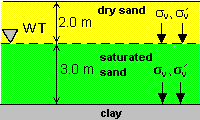
|
| (a) At the top of saturated sand (z = 2.0 m) | ||
| Vertical total stress | sv = 16.0 x 2.0 | = 32.0 kPa |
| Pore pressure | u = 0 | |
| Vertical effective stress | s´v = sv - u | = 32.0 kPa |
| (b) At the top of the clay (z = 5.0 m) | ||
| Vertical total stress | sv = 32.0 + 20.0 x 3.0 | = 92.0 kPa |
| Pore pressure | u = 9.81 x 3.0 | = 29.4 kPa |
| Vertical effective stress | s´v = sv - u = 92.0 - 29.4 | = 62.6 kPa |
Effect of changing water table |
Calculation of vertical stress |
| The figure shows soil layers on a site. The unit weight of the silty sand is 19.0 kN/m³ both above and below the water table. The water level is presently at the surface of the silty sand, it may drop or it may rise. The following calculations show the effects of this: | |
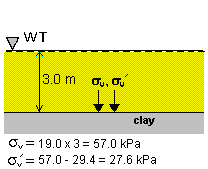 |
|
Stresses under foundations |
Calculation of vertical stress |
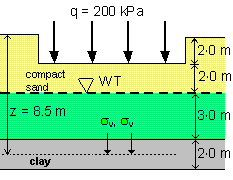
From an initial state, the stresses under a foundation are first changed by excavation, i.e. vertical stresses are reduced. After construction the foundation loading increases stresses. Other changes could result if the water table level changed.
The figure shows the elevation of a foundation to be constructed in a homogeneous soil. The change in thickness of the clay layer is to be calculated and so the initial and final effective stresses are required at the mid-depth of the clay.
Unit weights: sand above WT = 16 kN/m³, sand below WT = 20 kN/m³, clay = 18 kN/m³.
| Calculation of vertical stress |
Short-term and long-term stresses |
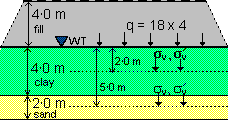
The figure shows how an extensive layer of fill will be placed on a certain site.
| Short-term and long-term stresses |
Initially, before construction |

Initial stresses at mid-depth of clay (z = 2.0m)
Vertical total stress
sv = 20.0 x 2.0 = 40.0kPa
Pore pressure
u = 10 x 2.0 = 20.0kPa
Vertical effective stress
s´v = sv
- u = 20.0kPa
Initial stresses at mid-depth of sand (z = 5.0 m)
Vertical total stress
sv = 20.0 x 5.0 = 100.0 kPa
Pore pressure
u = 10 x 5.0 = 50.0 kPa
Vertical effective stress
s´v = sv
- u = 50.0 kPa
| Short-term and long-term stresses |
Immediately after construction |

The construction of the embankment applies a surface surcharge:
q = 18 x 4 = 72.0 kPa.
The sand is drained (either horizontally or into the rock below) and so there is no increase in pore pressure. The clay is undrained and the pore pressure increases by 72.0 kPa.
Initial stresses at mid-depth of clay (z = 2.0m)
Vertical total stress
sv = 20.0 x 2.0 + 72.0 = 112.0kPa
Pore pressure
u = 10 x 2.0 + 72.0 = 92.0 kPa
Vertical effective stress
s´v = sv
- u = 20.0kPa
(i.e. no change immediately)
Initial stresses at mid-depth of sand (z = 5.0m)
Vertical total stress
sv = 20.0 x 5.0 + 72.0 = 172.0kPa
Pore pressure
u = 10 x 5.0 = 50.0 kPa
Vertical effective stress
s´v = sv
- u = 122.0kPa
(i.e. an immediate increase)
Many years after construction |
Short-term and long-term stresses |

After many years, the excess pore pressures in the clay will have dissipated. The pore pressures will now be the same as they were initially.
Initial stresses at mid-depth of clay (z = 2.0 m)
Vertical total stress
sv = 20.0 x 2.0 + 72.0 = 112.0 kPa
Pore pressure
u = 10 x 2.0 = 20.0 kPa
Vertical effective stress
s´v = sv
- u = 92.0 kPa
(i.e. a long-term increase)
Initial stresses at mid-depth of sand (z = 5.0 m)
Vertical total stress
sv = 20.0 x 5.0 + 72.0 = 172.0 kPa
Pore pressure
u = 10 x 5.0 = 50.0 kPa
Vertical effective stress
s´v = sv
- u = 122.0 kPa
(i.e. no further change)
Steady-state seepage conditions | Calculation of vertical stress |

The figure shows seepage occurring around embedded sheet piling.
In steady state, the hydraulic gradient,
i = Dh / Ds = 4 / (
7 + 3 ) = 0.4
Then the effective stresses are:
s´A = 20 x 3 - 2 x 10 + 0.4 x
10 = 44 kPa
s´B = 20 x 3 - 2 x 10 - 0.4 x
10 = 36 kPa